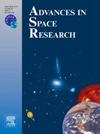Geospatial and NDBI approaches for the Musi River basin morphometric studies in the metropolitan urban Cities of India
IF 2.8
3区 地球科学
Q2 ASTRONOMY & ASTROPHYSICS
引用次数: 0
Abstract
This study aims to advance the understanding of hydrological dynamics and geomorphological characteristics of the Musi River Basin through the novel application of Remote Sensing (RS) and Geographical Information System (GIS)-based morphometric analysis across three delineated sub-basins (SB-1, SB-2, SB-3). By examining parameters such as stream order, bifurcation ratio, drainage density, and land cover changes using the Normalized Difference Built-up Index (NDBI), the study provides a comprehensive overview of the basin’s surface hydrology and urbanization impact. Key findings reveal low surface runoff and high permeability, supported by low drainage density (0.64 km/km2) and stream frequency (0.48 streams/km2). SB-3′s elevated bifurcation ratio (5.0) highlights substantial structural control, contrasting with moderate bifurcation ratios in SB-1 and SB-2. Hypsometric analysis indicates a transition from youthful to mature phases across the basin, with SB-3′s ruggedness values reflecting moderate erosion. A 21-year land cover analysis (2000–2021) based on NDBI highlights notable changes: water bodies (2.67 %), moisture soils (5.04 %), built-up lands (3.10 %), and vegetation (2.74 %) have all increased, while fallow lands/wastelands decreased by 13.54 %. The urban expansion, driven by rapid population growth, underscores pressing ecosystem challenges. Validation of the land cover analysis yielded a robust AUC score of 0.840, affirming the reliability of the NDBI-based classification. This research showcases the efficacy of DEM-based morphometric methods for precise catchment delineation and stream order classification, providing critical insights for effective water resource management and watershed planning in the Musi River Basin.
印度大城市Musi河流域形态测量研究的地理空间和NDBI方法
本研究旨在通过基于遥感和地理信息系统(GIS)的木思河流域3个子流域(SB-1、SB-2、SB-3)形态计量学分析的新应用,促进对木思河流域水文动力学和地貌特征的认识。通过使用归一化差异建筑指数(NDBI)检查河流顺序、分岔比、排水密度和土地覆盖变化等参数,该研究提供了流域地表水文和城市化影响的全面概述。主要研究结果显示,低地表径流量和高渗透性是由低排水密度(0.64 km/km2)和低溪流频率(0.48个溪流/km2)支持的。与SB-1和SB-2的中等分岔率相比,SB-3的高分岔率(5.0)突出了实质性的结构控制。假设分析表明,整个盆地从年轻阶段过渡到成熟阶段,SB-3的坚固度值反映了中度侵蚀。基于NDBI的21年土地覆盖分析(2000-2021)显示出显著的变化:水体(2.67%)、湿润土壤(5.04%)、建设用地(3.10%)和植被(2.74%)均有所增加,而休耕地/荒地减少了13.54%。在人口快速增长的推动下,城市扩张凸显了生态系统面临的紧迫挑战。对土地覆盖分析的验证得出了0.840的稳健AUC得分,证实了基于nbi的分类的可靠性。本研究展示了基于dem的形态测量方法在精确流域划定和溪流顺序分类方面的有效性,为木斯河流域有效的水资源管理和流域规划提供了重要见解。
本文章由计算机程序翻译,如有差异,请以英文原文为准。
求助全文
约1分钟内获得全文
求助全文
来源期刊

Advances in Space Research
地学天文-地球科学综合
CiteScore
5.20
自引率
11.50%
发文量
800
审稿时长
5.8 months
期刊介绍:
The COSPAR publication Advances in Space Research (ASR) is an open journal covering all areas of space research including: space studies of the Earth''s surface, meteorology, climate, the Earth-Moon system, planets and small bodies of the solar system, upper atmospheres, ionospheres and magnetospheres of the Earth and planets including reference atmospheres, space plasmas in the solar system, astrophysics from space, materials sciences in space, fundamental physics in space, space debris, space weather, Earth observations of space phenomena, etc.
NB: Please note that manuscripts related to life sciences as related to space are no more accepted for submission to Advances in Space Research. Such manuscripts should now be submitted to the new COSPAR Journal Life Sciences in Space Research (LSSR).
All submissions are reviewed by two scientists in the field. COSPAR is an interdisciplinary scientific organization concerned with the progress of space research on an international scale. Operating under the rules of ICSU, COSPAR ignores political considerations and considers all questions solely from the scientific viewpoint.
 求助内容:
求助内容: 应助结果提醒方式:
应助结果提醒方式:


